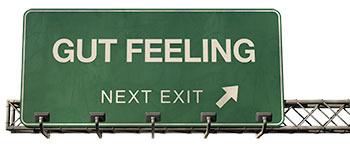It All Depends
In response to the rhetorical question posed in the title of this month’s article, my answer is “it all depends.” If the decision at hand is fairly straightforward; if the decision maker has considerable experience and if the impact of a poor or bad decision is negligible, a gut feel or intuition is probably OK. Faced with well-reasoned and evaluated alternatives a seasoned decision maker could also draw on his/her intuition to contribute to making a good choice from a set of competing alternatives.
There are, however, inherent dangers in drawing on gut feel and intuition even when decisions may appear to be relatively simple. When decisions become more complex, particularly where predictions about future revenues, profits, investments and other business decisions are involved, subjective judgment can lead to serious consequences. Consider: if you had been the CEO of Bank of America, would you have invested in Countrywide or Merrill-Lynch? From published accounts, it appears that there was a lot of gut-feel behind these decisions, rather than careful evaluation of the risks involved.
Gut feel can easily be biased by overreaction to “available information” — a common barrier to quality decision making. In their best-selling book “Decision Traps” (Amazon), J. Edward Russo and Paul Schoemaker observe that “People often seem to implicitly assume the information that is most easily available to them is also the most relevant information.” Psychologists call this availability bias.

Smarter Decisions Take More Effort
Intuition or “gut feel” may be fine, say Russo and Schoemaker, for small decisions where “your mind processes part or all of the information you possess automatically, quickly, and without awareness of any details.” However, they point out, “The disadvantages of intuitive decision making are more profound than most people realize.” “People making decisions by intuition alone usually suffer from ‘information overload’ and have a hard time applying simple rules consistently even when they try.”
In November’s ValuePoint, I referred to Nate Silver’s book, “The Signal and the Noise: Why So Many Predictions Fail – But Some Don’t” (Amazon). Now that the election is over and Mr. Obama is entering his second term, it’s time to revisit Mr. Silver. Long before the 2012 election, this writer of the blog “538” predicted an Obama victory amid the fuzz and fury of the then-raging campaign. His prediction, based on a probabilistic model barely changed during much of the presidential campaign despite events seen as potential game-changers, including opinion polls, changing economic data and the “other daily flotsam of election campaigns” (The Economist, 6 October 2012). Consider your thoughts during the final months of the campaign, when bombarded by poll after poll, radio and TV pundits, etc.; perhaps you found yourself giving in to availability bias.
In “Think Twice: Harnessing the Power of CounterIntuition” (Amazon), Michael J. Mauboussin also challenges the value of intuition in decision-making. He argues in this quote from Bloomberg Business Week, “Among the most galling aspects of the financial crisis is that intelligent people made so many decisions that later seemed obviously, pathetically wrong. Greed, and even a certain mean-spiritedness, were evident in the choices bankers, mortgage brokers, appraisers, and many others made. But maybe the most important failure was cognitive. People thought about risks and consequences (if they did at all) the wrong way.”
Mauboussin draws on the work of Daniel Kahneman, who described two systems of decision-making in his best-selling book “Thinking, Fast and Slow” (Amazon) – “The first is experiential; it’s fast, automatic, and difficult to control. The second is analytical: it’s slower, serial, and takes effort.” He goes on to say, “We can try to train our gut to produce more reliable responses.”
But, while intuition may work at times, it’s “better simply to recognize the limits of intuition,” adding “We can train our intuition to be more reliable. But smarter decisions simply tend to take more effort.”
As readers of ValuePoint will recognize, there are other barriers to good decision-making. For reference see back issues available on the SmartOrg website. I also invite you to add the books cited above to your reading list.



